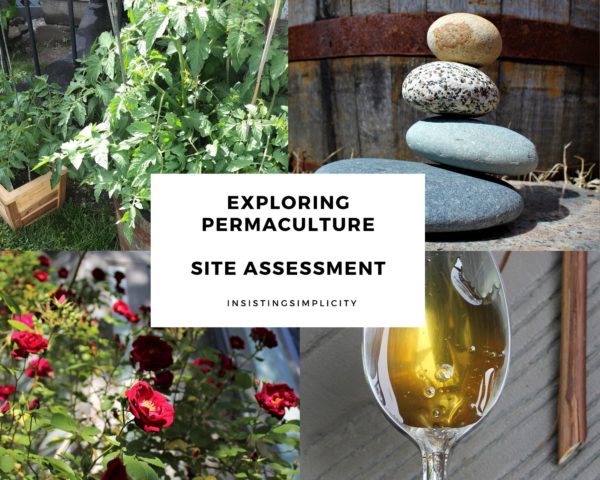Cold, snowy days prompt daydreams of sun and dirt! On this wintry day, I’d like to share some thoughts regarding the permaculture design process. Good design begins with a good eye. That eye, however, may need to be retrained to envision the landscape slightly differently. Please enjoy this exploration into permaculture design: Site Assessment.

Site Assessment
Each site is unique. A 1,000+ acre plot of wilderness may be your desired location, where a patient, incremental approach over a long time horizon may be best suited. A micro parcel in an urban setting could be an appropriate location also, which presents a separate set of considerations.
I want to envision our condo and current residence as a homestead. You can call me JR Ingalls Wilder and this is our Little Condo on the Asphalt.
Naturally, unique considerations accompany urban dwelling, like noise and pollution, for example. Conversely, some of the “major” concerns facing your “traditional” farmer, like water sources/irrigation, may be less prevalent with a small plot.
It may be helpful to take a cue from Jessi Bloom and Dave Boehnlein’s Practical Permaculture for Home Landscapes, Your Community, and the Whole Earth. They distinguish between observation and interpretation. They write: “… observation is a fact, a statement of an observed phenomenon. An interpretation is a guess at why the phenomenon is happening.” For novices (like me!), it might be a good idea to mentally situate oneself firmly in the realm of observation before we attempt to make inferences. This could save time and energy later, while maintaining a present mindset. Let’s not get ahead of ourselves!
When first poking about, you’re likely to encounter what I’ll call the “Barry O you didn’t build that” issue.
To elaborate: regardless of site location, artifacts left by previous humans and/or critters will likely exist. A rotting fence halfway stuck in the ground, a discarded toilet bowl from 1967 that someone decided to chuck down an embankment or an overturned root structure that an animal made into a den last season are examples of observable artifacts.
There are myriad examples of stuff, things, evidence of what came before us if we adopt an inquisitive disposition. Questions that may be helpful to the aspiring permaculturist include:
- Can we reuse it in its current form for its original purpose?
- Can we reuse it in its current form for an alternative purpose?
- Can we re-purpose and reuse it in an alternative way?
and so on…
Let’s apply this thinking to our situation. M (my fiance) and I live in what I call a “standard triple decker,” a typical three level home design. In more recent years, contractors refurbish, section off by floor and rent or “condo” them out. Therefore, over just the last few decades, many of these properties have seen multiple owners and a high tenant turnover.
This begs the questions:
- What is already there?
- What resources, tools, materials are already available?
- What plants, trees and shrubs are already established, thriving or struggling?
Get a good feel for the existing lay-out and what others have done before you.
Crawl Before You Walk
Let me quickly back up a couple of years. We wanted to try our hand at some gardening, so we got some tomato plants. They did well and by the following year (2019 growing season), we were ready to branch out with vegetables, herbs and other experimentation.
So, here we are. That was quick! Season three.
Let’s start 2020 right with some real observation, properly executed in the stillness of the morning hours, fresh of mind and well into a strong cup of home-brewed coffee.
Site Assessment Considerations:
- Initial observations
- A variety of flowers and shrubs fill the beds
- Great for pollinators
- Designed for aesthetics, not an edible landscape
- Small plot, but intended for growing
- Medium sized dogwood tree blocks foot/street traffic
- Small lawn
- A variety of flowers and shrubs fill the beds
- Notable unique characteristics
- Opportunities to foster micro-climates created by buildings
- Challenges to sun exposure created by buildings
- Two porches and spiral staircase create opportunities for vertical farming, trellis construction, etc.
- Soil test?
- We used an over-the-counter soil test last season, it confirmed what we already knew – the soil stinks big time!
- Sandy, nutrient-depleted, filled with miscellaneous “city junk,” like chunk concrete debris, metal, plastic, you name it
- No mulching in recent seasons – topsoil erosion, inability to retain soil moisture
- Water sources? Water table?
- We’ve used water from our outdoor hose, no rain water recycling systems used (yet)
- Limited space and proximity to the homestead make water resources, water capture less of a priority currently
This is not an exhaustive study, nor overly scientific, but it helps me identify the important facts of the site. This will constitute the basis for my analysis and inform our action plan.
I want to underline a subtle, but important concept that Bloom and Boehnlein lay out in Practical Permaculture. They describe the permaculture “transition ethic,” which simply means, “… no one is going from zero to sustainable overnight. Making that transition takes time.” The implications from this are many. Interpret as you like, but for me, this notion puts me at ease. I don’t have to ascribe to some ill-conceived and arbitrary mental time-frame, or compare myself to others or incessantly question what is and isn’t the “right” way.
Instead, I want my efforts to come from a genuine desire to limit my footprint upon the environment. I want to learn about the things that interest me at my own pace, and experience the simple pleasure that accompanies a better connection with the land.
I hope you’ll join me…
Next Steps:
- Site Analysis

